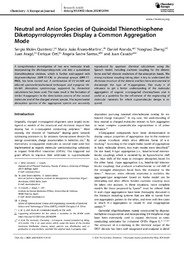Please use this identifier to cite or link to this item:
https://hdl.handle.net/11000/33850Full metadata record
| DC Field | Value | Language |
|---|---|---|
| dc.contributor.author | Moles Quintero, Sergio | - |
| dc.contributor.author | Álvaro Martins, Maria Joao | - |
| dc.contributor.author | Aranda Ruiz, Daniel | - |
| dc.contributor.author | Zheng, Yonghao | - |
| dc.contributor.author | Aragó, Juan | - |
| dc.contributor.author | Ortí, Enrique | - |
| dc.contributor.author | Sastre-Santos, Ángela | - |
| dc.contributor.author | Casado Cordón, Juan | - |
| dc.contributor.other | Departamentos de la UMH::Farmacología, Pediatría y Química Orgánica | es_ES |
| dc.date.accessioned | 2024-11-14T09:59:28Z | - |
| dc.date.available | 2024-11-14T09:59:28Z | - |
| dc.date.created | 2024-07-19 | - |
| dc.identifier.citation | Chemistry - A European Journal, 2024 | es_ES |
| dc.identifier.issn | 1521-3765 | - |
| dc.identifier.issn | 0947-6539 | - |
| dc.identifier.uri | https://hdl.handle.net/11000/33850 | - |
| dc.description.abstract | A comprehensive investigation of two new molecular triads incorporating the diketopyrrolopyrrole unit into a quinoidized thienothiophene skeleton, which is further end-capped with dicyanomethylene (DPP-TT-CN) or phenoxyl groups (DPP-TT-PhO), has been carried out. A combination of UV-Vis-NIR and infrared spectroelectrochemical techniques and cryogenic UV-Vis-NIR absorption spectroscopy supported by theoretical calculations has been used. The main result is the formation of similar H-aggregates in the dimerization process of the neutral molecules and of the charged anionic species. The experimental absorption spectra of the aggregated species are accurately reproduced by quantum chemical calculations using the Spano's model, including excitonic coupling for the dimeric forms and full vibronic resolution of the absorption bands. The strong excitonic coupling taking place is key to understand the electronic structure of the dimeric species and has been instrumental to disentangle the type of H-aggregation. This study is of relevance to get a better understanding of the molecular aggregation of organic π-conjugated chromophores and is useful as a guideline for the refinement of the engineering of molecular materials for which supramolecular design is required. | es_ES |
| dc.format | application/pdf | es_ES |
| dc.format.extent | 14 | es_ES |
| dc.language.iso | eng | es_ES |
| dc.publisher | Wiley | es_ES |
| dc.rights | info:eu-repo/semantics/openAccess | es_ES |
| dc.rights | Attribution-NonCommercial-NoDerivatives 4.0 Internacional | * |
| dc.rights.uri | http://creativecommons.org/licenses/by-nc-nd/4.0/ | * |
| dc.subject.other | CDU::5 - Ciencias puras y naturales::54 - Química | es_ES |
| dc.title | Neutral and Anion Species of Quinoidal Thienothiophene Diketopyrrolopyrroles Display a Common Aggregation Mode | es_ES |
| dc.type | info:eu-repo/semantics/article | es_ES |
| dc.relation.publisherversion | https://doi.org/10.1002/chem.202402094 | es_ES |

View/Open:
202402094.pdf
2,81 MB
Adobe PDF
Share:
.png)
